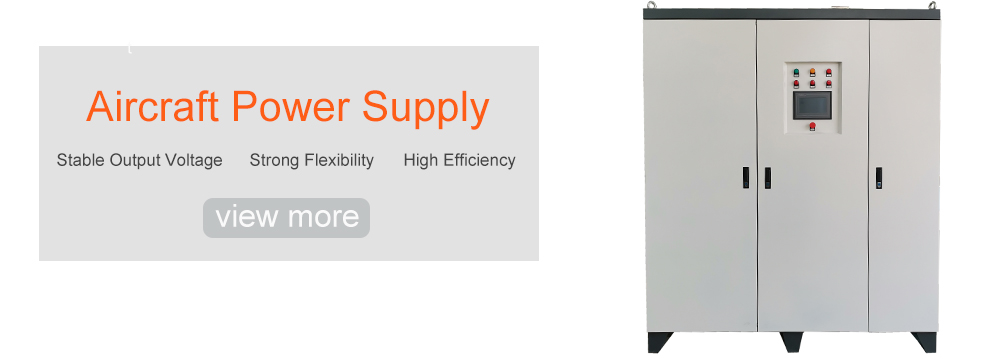With the rapid development of modern scientific aviation technology, the number of electrical equipment used in modern aircraft has increased significantly, and it is developing towards multi-electric and all-electric aircraft. It has become a trend to use electrical energy to replace mechanical energy, hydraulic energy, and air pressure energy.
This will cause a sharp increase in aircraft power consumption. In order to ensure that electrical equipment can work normally under various conditions, higher requirements are placed on the reliability and performance of aircraft power supplies.
This requires more stringent testing of the power supply system at the factory, such as reliability testing (aging discharge testing), output characteristic testing, etc. At present, domestic aviation power supply factory testing and power supply testing by scientific research institutes all use resistance boxes or water resistance test benches as loads.
This traditional test method has many disadvantages: the load adopts step-by-step adjustment, the resistance power is small, the test power is all consumed on the resistance, and the load equipment is large in size and occupies a large space.
With the development of semiconductor technology, the rapid development of power electronic conversion technology, especially the continuous emergence and application of various current control technologies, has led to the emergence of electronic loads that can simulate traditional real impedance loads.

Aircraft power supply system
The aircraft power supply system is an important part of the aircraft power supply system, including the main power supply, auxiliary power supply, emergency power supply and secondary power supply.
The main power supply of the aircraft consists of a generator and its transmission, regulation, control and protection devices, which supply power to the electrical equipment of the aircraft in normal flight; the auxiliary power supply is a generator driven by an aviation battery or an auxiliary power unit, which works when the main power supply is not working; the emergency power supply includes aviation batteries and wind turbine generators.
Once the main power supply fails during flight and cannot supply power normally, the emergency power supply will supply power; the secondary power supply is a device that converts one form of electrical energy of the main power supply into different voltages, currents and qualities to meet the requirements of different electrical equipment for different forms of electrical energy.
Aviation electronic load is a reliable and comprehensive test of the output characteristics and reliability (aging discharge test) of the output electrical energy equipment or conversion device in the aircraft power supply system, such as generators, AC/DC, DC/AC converters, aviation batteries, rectifiers, and inductors, capacitors and other components.
Principle of electronic load
An electronic load is a load that absorbs electrical energy using electronic components and consumes it. The electronic components are generally power semiconductor devices such as power field effect transistors (PowerMOS) and insulated gate bipolar transistors (IGBT).
The energy feedback type electronic load is an energy-saving electronic load that feeds back the test energy to the power grid on the premise of realizing the power supply test, realizing the recycling of electric energy.
The input of the electronic load is the output of the test power supply, and the output is connected to the low-voltage power grid 220∕380V. On the input side, the electronic load must accurately control the size and phase of the input current so that the impedance value or current value presented to the power supply is the set value; on the output side, the output current must be controlled to be in phase with the grid voltage to realize the unit power factor feedback of the test power.
The working modes of the electronic load are: constant current mode, constant resistance mode, constant voltage mode and dynamic test modes such as overvoltage, overcurrent, and short circuit. Among them, the constant current mode is used to test the load regulation rate of the voltage source and AC/DC power supply.
The load regulation rate is the ability of the power supply to provide a stable output voltage when the load changes, and it is the percentage of the output voltage deviation rate of the power supply; the constant resistance mode is usually used to test the activation and current limiting characteristics of the voltage or current source; the constant voltage mode is used to test the current limiting characteristics of the power supply.
Because the voltage is a fixed value, it can simulate the battery terminal voltage and test the battery charger; the dynamic test mode is to simulate various faults or sudden changes of some parameters in the power supply system by controlling the electronic load to test the reliability of the system.
Summarize
In the context of the current maturity of civilian DC electronic loads and the in-depth research of AC electronic loads, in view of the shortcomings of the current domestic aviation power supply test, the power feedback electronic load is applied to the aviation power supply test, and its feasibility is demonstrated from the aspects of the topological structure, control method and control strategy of the aviation electronic load.
The aviation electronic load based on power feedback has the advantages of small size, energy saving, and high automation, which will bring huge economic benefits to the defense industry.







